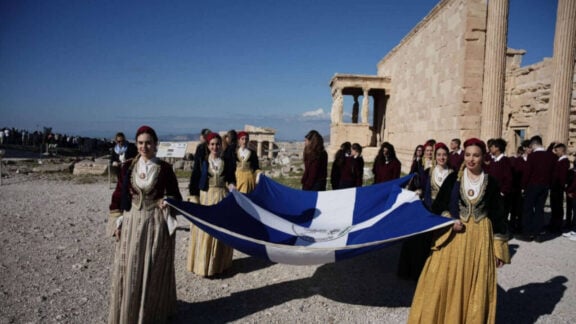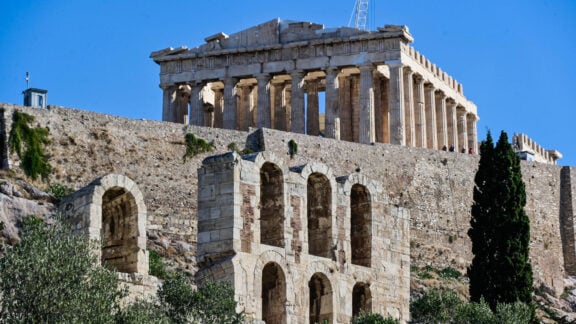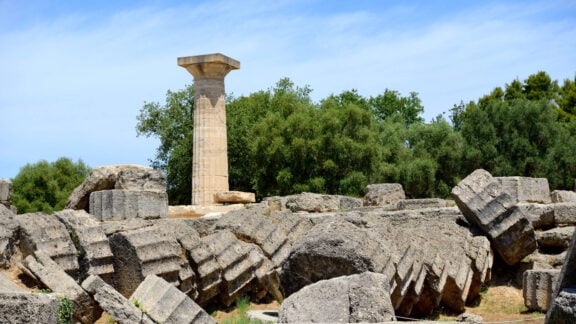There are many things that are similar in the way Christmas and New Year are celebrated in Australia and in Greece. For example, there is the Father Christmas figure, the decorated Christmas tree, the feast, and, most importantly, the handing out of presents.
But there are differences too.
The Christmas tree came to Greece from Northern Europe. In the islands of Greece and the towns on the coast, instead of a tree they decorate a model of a boat or a ship that reminds people of how important the sea is to their lives.
Father Christmas in the West, or Santa Claus is St Nicholas while in Greece, Father Christmas is St Basil (Ayios Vasilis) and gifts are traditionally given on New Year’s Day, which is also St Basil’s Day. The image that we associate with Santa Claus of the big tubby man with the white beard and red clothes and black boots is actually drawn from a Coca Cola advertisement campaign of the 1920s.

The vasilopita cake with the lucky coin inside is traditionally prepared and eaten in Greece on 1 January. In the northern parts of Greece, the vasilopita is not prepared as a sweet cake but as a savoury pie with symbolic gifts placed inside.
Other traditional Greek sweets are the kourambiedes, melomakarona and Christopsomo. In Arnaia in Central Macedonia, they offer To Meloma to Christou (the Honey Offer to Christ) which is Christopsomo with offerings of honey, walnuts and wine.
Under normal conditions, on Christmas Eve, the village would prepare a Christopsomo that weighs over 200kg. After it is blessed the bread would be shared by the villagers and their guests to be enjoyed with bowls of honey, wall nuts and a glass of wine.
READ MORE: Greek Christmas food traditions: Melomakarona
The singing of Christmas carols is another tradition shared by other countries. In Greece, kids go from house to house in their neighbourhoods to sing the carols (kalanda) in the hope of getting a gift of sweets or money. It was always a good source of extra money.
Another Greek tradition that is held during the Christmas period (the 12 days of Christmas – Dodekaimeron – from 25 December to 5 January) is the lighting of the log dedicated to Christ and also known as the “12-day log”. The log is meant to burn in the fireplace throughout the 12 days of Christmas to keep everyone safe from goblins (kalikantzarous).
In the Kozani region of West Macedonia, in the town of Siatista, each neighbourhood digs a large hole in an open space to erect a Klatharia made of dry brushwood that is built up a big log (vergi) can be as high as five metres.
The people tie a bundle of grass called a founta to the construction and decorate with balloons and other decorations.
Children will clang sheep bells as the fire is lit under the whole construction on the night of 23 December. The same tradition is followed in other parts of northern Greece. Under normal circumstances, the events would be an occasion for dance and music.
While the Christmas Turkey is becoming a popular meat for dish for this time of the year, the pig is the traditional meat of choice for the Greek Christmas feast, especially in northern Greece.
It is a tradition dating back to Ancient Greek and Roman times when the Saturnalia was celebrated in December. The traditions were maintained during the Byzantine era to continue to the present day. In ancient times December was the month that market the turning point in winter. From 21 December onwards, the days start to get longer again and this fact sparked the celebrations that have now become part of the Christmas tradition.

The Kotsamania or Momoeria is another tradition that has lived through the ages and been kept alive by the Pontian communities throughout Greece.
The tradition owes much to the ancient Greek god Momus the god of satire and mockery. His constant mockery of the ancient gods led to Zeus exiling him from Mount Olympus which was the home of the gods.
The origins of theatre are traced to Momus and his satire. The Momoeria of Kotsomania is an opportunity to celebrate street theatre. It is a time groups of actors or “mummers” go out on the streets to perform in fantastic costumes.
The groups are often made up of a leader and 12 actors who represent the 12 months of the year. They often represent symbolic characters including the Bride and Groom, the Doctor, the Old Man and Woman, the Devil, the Policeman and the Judge. Also part of the the cast, is the Dikolon, a hunchback who carries his dead brother on his back and the Bear. In the village of Tetralofos in Kozani, the event is held over Christmas and Boxing Day.
There are many more special celebrations during the Christmas and New Year festive season that are celebrated in different parts of Greece. Some of these traditions go back thousands of years. Ask your yiayia and pappou to tell you how they celebrated Christmas when they were young and you will be sure to hear stories that are worth remembering.
* Much of the information for this article was drawn from A Greek Folk Journey, Travel Culture & Gastronomy by Terina Armenakis. There are updates via A Greek Folk Journey Instagram link.
READ MORE: At a Greek Christmas the table groans with a rich and varied fare









